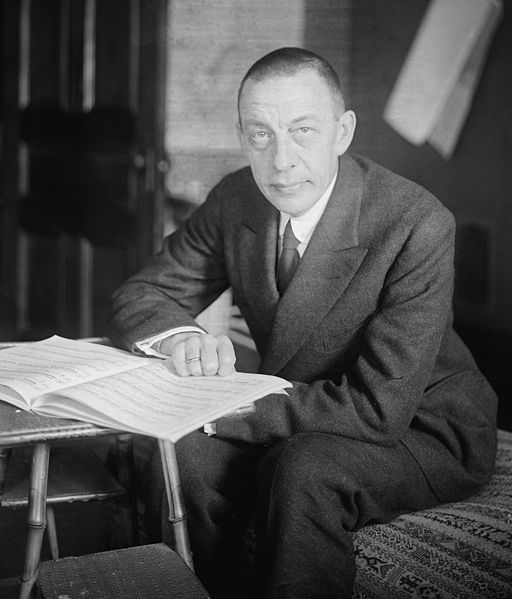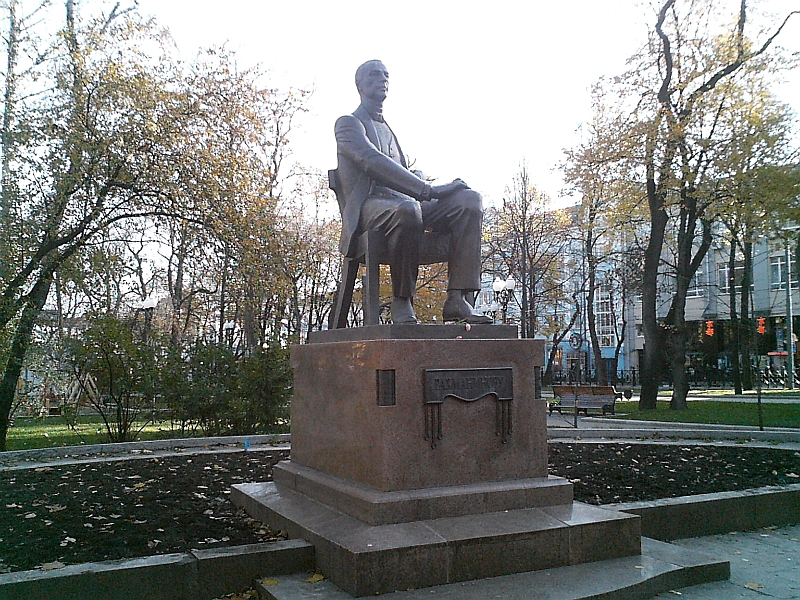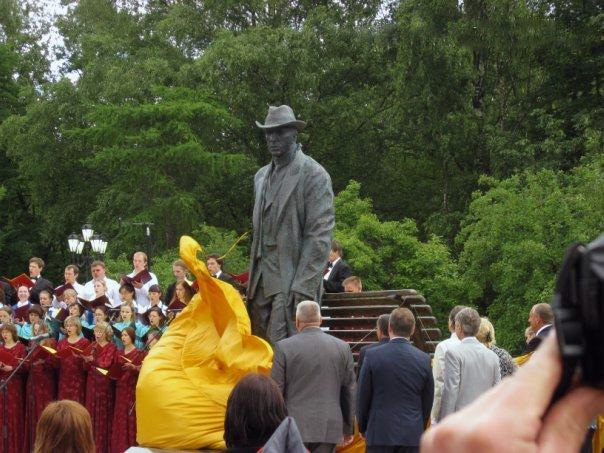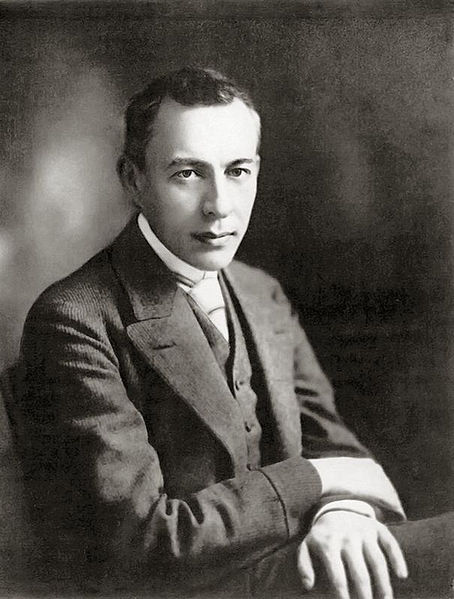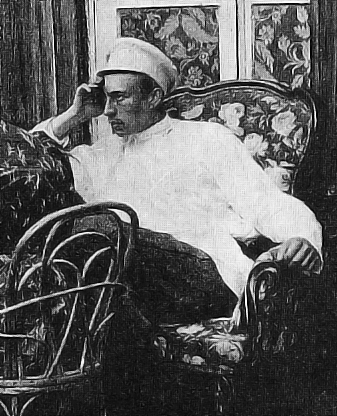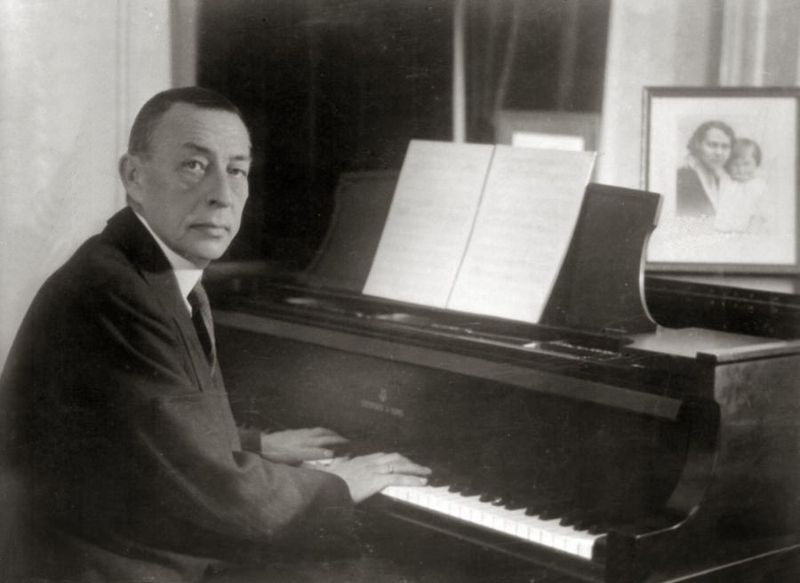<Back to Index>
- Composer, Pianist and Conductor Sergei Vasilievich Rachmaninoff, 1873
PAGE SPONSOR
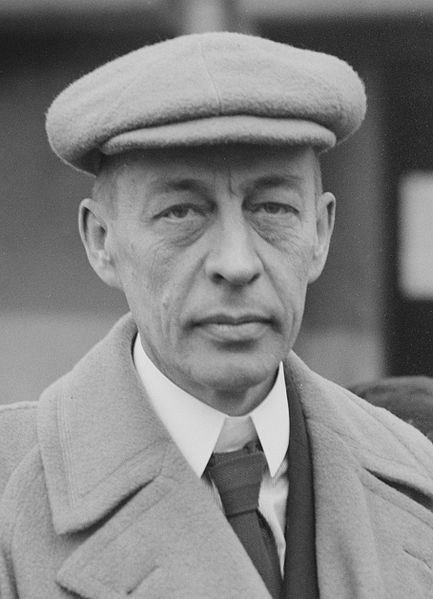
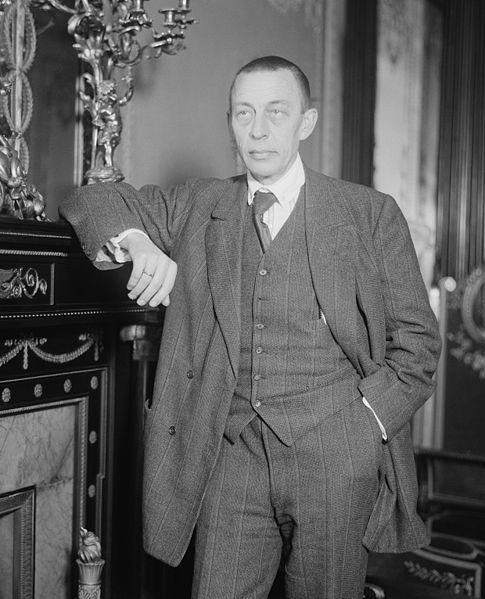
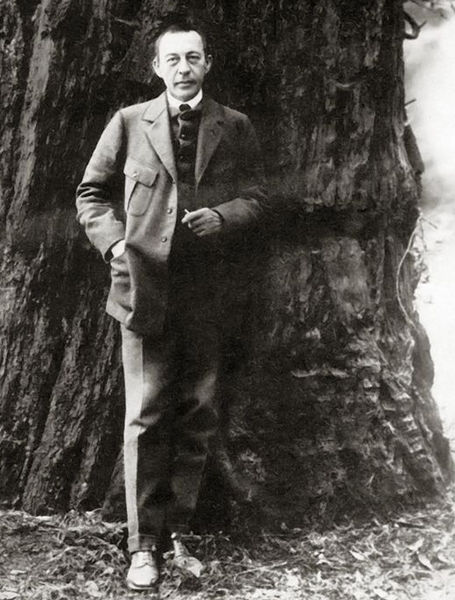
Sergei Vasilievich Rachmaninoff (Russian: Сергей Васильевич Рахманиновъ) (1 April 1873 – 28 March 1943) was a Russian composer, pianist, and conductor. Rachmaninoff is widely considered one of the finest pianists of his day and, as a composer, one of the last great representatives of Romanticism in Russian classical music. Early influences of Tchaikovsky, Rimsky - Korsakov, and other Russian composers gave way to a thoroughly personal idiom that included a pronounced lyricism, expressive breadth, structural ingenuity, and a tonal palette of rich, distinctive orchestral colors. The piano is featured prominently in Rachmaninoff's compositional output. He made a point of using his own skills as a performer to explore fully the expressive possibilities of the instrument. Even in his earliest works he revealed a sure grasp of idiomatic piano writing and a striking gift for melody.
Rachmaninoff was born on 1 April [O.S. 20 March] 1873 in Semyonovo, near Great Novgorod, in north - western Russia into a family of the Russian aristocracy, originally of partly Tatar descent, which had been in the service of the Russian tsars since the 16th century. His parents were both amateur pianists. When he was four, his mother gave him casual piano lessons, but it was his paternal grandfather, Arkady Alexandrovich Rachmaninoff, who brought Anna Ornatskaya, a teacher from Saint Petersburg, to teach the 9 year old Sergei in 1882. Ornatskaya remained for two or three years, until the family's house in Semyonovo had to be sold to settle debts and the Rachmaninoffs moved to Saint Petersburg.
Rachmaninoff studied at the Saint Petersburg Conservatory before moving alone to Moscow at age 14 to enroll at the Moscow Imperial Conservatory. His parents arranged for him to live in the home of his piano teacher, the severe and autocratic Nikolai Zverev
who, Rachmaninoff admitted in later interviews, instilled in the
formerly rather lazy boy the disciplined work habits which would serve
him well.
The young Rachmaninoff showed great skill in both piano and composition which he studied with Anton Arensky, and while still a student he wrote the one act opera, Aleko, for which he was awarded a gold medal in composition. His First Piano Concerto, and a group of piano pieces, Morceaux de fantaisie (Op. 3, 1892), a set which includes the famous Prelude in C sharp minor followed. It was the great success of this Prelude (Op. 3, No. 2), which sold thousands of copies under various and sometimes lurid titles, that made Rachmaninoff a well known composer both in Russia and in the West, however he came eventually to detest it since it was so often demanded as an encore at his recitals. In later years he sometimes teased an expectant audience by asking, "Oh, must I?" or claiming an inability to remember it. Zverev and his student fell out over Rachmaninoff's ambition to be a composer and Alexander Siloti, who was Rachmaninoff's cousin and had been one of the greatest of Franz Liszt's pupils, became his teacher.
While still a student at the Conservatory, he met the composer Pyotr Ilyich Tchaikovsky, who became an important mentor and commissioned the teenage Rachmaninoff to arrange a piano transcription of the suite from his ballet The Sleeping Beauty. This commission had first been offered to Siloti, who declined, but suggested instead that Rachmaninoff would be more than capable. Siloti supervised the arrangement which became the first of many brilliant and effective transcriptions Rachmaninoff would write over the course of his career. He graduated from the Conservatory in 1892 in an extraordinary class in which he shared the Gold Medal for Piano with Josef Lhevinne and fellow composer / pianist Alexander Scriabin.
The sudden death of Tchaikovsky in 1893 was a great blow to young Rachmaninoff; he immediately began writing a second Trio élégiaque in his memory, revealing the depth and sincerity of his grief in the music's overwhelming aura of gloom. His First Symphony (Op. 13, 1896) was premièred on 28 March 1897 in one of a long running series of "Russian Symphony Concerts", but was brutally panned by critic and nationalist composer César Cui who likened it to a depiction of the ten plagues of Egypt, suggesting it would be admired by the "inmates" of a music conservatory in hell. The deficiencies of the performance, conducted by Alexander Glazunov, were not commented on. Alexander Ossovsky in his memoir about Rachmaninoff tells, first hand, a story about this event.
In Ossovsky's opinion, Glazunov made poor use of rehearsal time, and
the concert program itself, which contained two other premières, was
also a factor. Natalia Satina, later Rachmaninoff's wife, and other
witnesses suggested that Glazunov, who was by all accounts an alcoholic,
may have been drunk, although this was never intimated by Rachmaninoff.
After the poor reception of his First Symphony, Rachmaninoff fell into a period of deep depression that lasted three years, during which he wrote almost nothing. One stroke of good fortune came from Savva Mamontov, a famous Russian industrialist and patron of the arts, who two years earlier had founded the Moscow Private Russian Opera Company. He offered Rachmaninoff the post of assistant conductor for the 1897–8 season and the cash strapped composer accepted. The company included the great basso Feodor Chaliapin who would become a lifelong friend. During this period he became engaged to fellow pianist Natalia Satina whom he had known since childhood and who was his first cousin. The Russian Orthodox Church and the girl's parents both opposed their marriage and this thwarting of their plans only deepened Rachmaninoff's depression.
In January 1900, Rachmaninoff and Chaliapin were invited to Yasnaya Polyana, the home of writer Leo Tolstoy, whom Rachmaninoff greatly admired. That evening, Rachmaninoff played one of his compositions, then accompanied Chaliapin in his song "Fate", one of the pieces he had written after his First Symphony. At the end of the performance, Tolstoy took the composer aside and asked, "Is such music needed by anyone? I must tell you how I dislike it all. Beethoven is nonsense, Pushkin and Lermontov also." (The song "Fate" is based on the two opening measures of Beethoven's Fifth Symphony.) As his guests were leaving, Tolstoy said, "Forgive me if I've hurt you by my comments," and Rachmaninoff graciously replied, "How could I be hurt on my own account, if I was not hurt on Beethoven's?" but the criticism of the great author stung nevertheless.
In the same year, Rachmaninoff began a course of autosuggestive therapy with psychologist Nikolai Dahl, who was himself an excellent though amateur musician. Rachmaninoff began to recover his confidence and eventually he was able to overcome his writer's block. In 1901 he completed his Piano Concerto No. 2 in C minor, Op. 18 and dedicated it to Dr. Dahl. The piece was enthusiastically received at its premiere at which Rachmaninoff was soloist and has since become one of the most popular and frequently played concertos in the repertoire. Rachmaninoff's spirits were further bolstered when, after three years of engagement, he was finally allowed to marry his beloved Natalia. They were wed in a suburb of Moscow by an army priest on 29 April 1902, using the family's military background to circumvent the church. The marriage was a happy one, producing two daughters - Irina, later Princess Wolkonsky (1903 - 1969) and Tatiana Conus (1907 - 1961). Although Rachmaninoff had an affair with the 22 year old singer Nina Koshetz in 1916, his and Natalia's union lasted until the composer's death. Natalia Rachmaninova died in 1951.
After several successful appearances as a conductor, Rachmaninoff was offered a job as conductor at the Bolshoi Theatre in 1904, although political reasons led to his resignation in March 1906, after which he stayed in Italy until July. He spent the following three winters in Dresden, Germany, intensively composing, and returning to the family estate of Ivanovka every summer.
Rachmaninoff made his first tour of the United States as a pianist in 1909, an event for which he composed the Piano Concerto No. 3 (Op. 30, 1909) as a calling card. These successful concerts made him a popular figure in America, however he was unhappy on the tour and declined requests for future American concerts until after he emigrated from Russia in 1917. This included an offer to become permanent conductor of the Boston Symphony Orchestra.
The early death in 1915 of Alexander Scriabin,
who had been his good friend and fellow student at the Moscow
Conservatory, affected Rachmaninoff so deeply that he went on a tour
giving concerts entirely devoted to Scriabin's music. When asked to play
some of his own music, he would reply, "Only Scriabin tonight".
The 1917 Russian Revolution meant the end of Russia as the composer had known it. With this change followed the loss of his estate, his way of life, and his livelihood. On 22 December 1917, he left St. Petersburg for Helsinki with his wife and two daughters on an open sled, having only a few notebooks with sketches of his own compositions and two orchestral scores, his unfinished opera Monna Vanna and Nikolai Rimsky - Korsakov's opera The Golden Cockerel. He spent a year giving concerts in Scandinavia while also laboring to widen his concert repertoire. Near the end of 1918, he received three offers of lucrative American contracts. Although he declined all three, he decided the United States might offer a solution to his financial concerns. He departed Kristiania (Oslo) for New York on 1 November 1918. Once there, Rachmaninoff quickly chose an agent, Charles Ellis, and accepted the gift of a piano from Steinway before playing 40 concerts in a four month period. At the end of the 1919 – 20 season, he also signed a contract with the Victor Talking Machine Company. In 1921, the Rachmaninoffs bought a house in the United States, where they consciously recreated the atmosphere of Ivanovka, entertaining Russian guests, employing Russian servants, and observing Russian customs.
Due to his busy concert career, Rachmaninoff's output as composer slowed tremendously. Between 1918 and his death in 1943, while living in the U.S. and Europe, he completed only six compositions. This was partly due to spending much of his time performing in order to support himself and his family, but the main cause was homesickness. It was during these years that he traveled the United States as a touring pianist. When he left Russia, it was as if he had left behind his inspiration. His revival as a composer became possible only after he had built himself a new home, Villa Senar on Lake Lucerne, Switzerland, where he spent summers from 1932 to 1939. There, in the comfort of his own villa which reminded him of his old family estate, Rachmaninoff composed the Rhapsody on a Theme of Paganini, one of his best known works, in 1934. He went on to compose his Symphony No. 3 (Op. 44, 1935 – 36) and the Symphonic Dances (Op. 45, 1940), his last completed work. Eugene Ormandy and the Philadelphia Orchestra premiered the Symphonic Dances in 1941 in the Academy of Music.
In late 1940 or 1941 he was approached by the makers of the British film Dangerous Moonlight to write a short concerto like piece for use in the film, but he declined. The job went to Richard Addinsell and the orchestrator Roy Douglas, who came up with the Warsaw Concerto.
Just as the Rachmaninoff household in the United States strove to reclaim the lost world of pre-revolutionary Russia, Rachmaninoff also sought out the friendship and company of some great Russian musical luminaries. In addition to Chaliapin, he befriended pianist Vladimir Horowitz in 1928.
Arranged by Steinway artist representative Alexander Greiner, their meeting took place in the basement of New York's Steinway Hall, on 8 January 1928, four days prior to Horowitz’s debut at Carnegie Hall playing the Tchaikovsky First Piano Concerto. Referring to his own Third Piano Concerto, Rachmaninoff said to Greiner he heard that “Mr. Horowitz plays my Concerto very well. I would like to accompany him.”
For Horowitz, it was a dream come true to meet Rachmaninoff, to whom he referred as “the musical God of my youth ... To think that this great man should accompany me in his own Third Concerto ... This was the most unforgettable impression of my life! This was my real debut!” Rachmaninoff was impressed by his younger colleague. Speaking of Horowitz’s interpretation to Abram Chasins, he said “He swallowed it whole ... he had the courage, the intensity, the daring.”
The meeting between composer and interpreter marked the beginning of a friendship that continued until Rachmaninoff's death. The two were quite supportive of each other's careers and greatly admired each other's work. Horowitz stipulated to his manager that “If I am out of town when Rachmaninoff plays in New York, you must telegraph me, and you must let me come back, no matter where I am or what engagement I have.” Likewise Rachmaninoff was always present at Horowitz’s New York concerts and was “always the last to leave the hall.”
Notably, the composer was present at Carnegie Hall for Horowitz’s American debut on 12 January 1928. Recognizing the great pianistic ability, Rachmaninoff offered his friendship and advice to Horowitz, telling him in a letter that “You play very well, but you went through the Tchaikovsky Concerto too rapidly, especially the cadenza." Horowitz never agreed with the criticism of his tempo, and retained his interpretation in future performances of the work.
Rachmaninoff and Horowitz frequently performed two - piano recitals at the composer's home in Beverly Hills. None of these performances, which included the Second Suite and the two - piano reduction of the Symphonic Dances, were recorded.
Rachmaninoff's faith in Horowitz's performances was such that, in 1940, with the composer's consent, Horowitz created a fusion of the 1913 original and 1931 revised versions of his Second Piano Sonata.
For Rachmaninoff, Horowitz was a champion of both his solo works and
his Third Concerto, about which Rachmaninoff remarked publicly after the
7 August 1942 Hollywood Bowl performance that “This is the way I always
dreamed my concerto should be played, but I never expected to hear it
that way on Earth.”
Rachmaninoff fell ill during a concert tour in late 1942 and was subsequently diagnosed with advanced melanoma. The family was informed but the composer was not. On 1 February 1943 he and his wife became American citizens. His last recital, given on 17 February 1943 at the Alumni Gymnasium of the University of Tennessee in Knoxville, included Chopin's Piano Sonata No. 2, which contains the famous Marche funèbre (Funeral March). A statue called "Rachmaninoff: The Last Concert", designed and sculpted by Victor Bokarev, now stands in World Fair Park in Knoxville as a permanent tribute to Rachmaninoff. He became so ill after this recital that he had to return to his home in Los Angeles.
Rachmaninoff died of melanoma on 28 March 1943, in Beverly Hills, California, just four days before his 70th birthday. A choir sang his All Night Vigil at his funeral. He had wanted to be buried at the Villa Senar, his estate in Switzerland, but the conditions of World War II made fulfilling this request impossible. He was therefore interred on 1 June in Kensico Cemetery in Valhalla, New York.
Rachmaninoff wrote five works for piano and orchestra — four concertos plus the Rhapsody on a Theme of Paganini. Of the concertos, the Second and Third are the most popular. He also wrote three symphonies, and his other orchestral works include The Rock (Op. 7), Caprice Bohémien (Op. 12), The Isle of the Dead (Op. 29), and the Symphonic Dances (Op. 45).
Works for piano solo include the Preludes, ten in Op. 23 and thirteen in Op. 32. Together with the Prelude in C-sharp minor (Op. 3, No. 2) from Morceaux de fantaisie (Op. 3), they traverse all 24 major and minor keys. Especially difficult are the two sets of Études - Tableaux, Op. 33 and 39, which are very demanding study pictures. Stylistically, Op. 33 hearkens back to the preludes, while Op. 39 shows the influences of Scriabin and Prokofiev. There are also the Six moments musicaux (Op. 16), the Variations on a Theme of Chopin (Op. 22), and the Variations on a Theme of Corelli (Op. 42). He wrote two piano sonatas, both of which are large scale and virtuosic in their technical demands. Rachmaninoff also composed works for two pianos, four hands, including two Suites (the first subtitled Fantasie - Tableaux), a version of the Symphonic Dances (Op. 45), and an arrangement of the C-sharp minor Prelude, as well as a Russian Rhapsody, and he arranged his First Symphony (below) for piano four - hands. Both these works were published posthumously.
Rachmaninoff wrote two major a cappella choral works — the Liturgy of St. John Chrysostom and the All - Night Vigil (also known as the Vespers). Other choral works include a choral symphony, The Bells, the Spring Cantata, the Three Russian Songs and an early Concerto for Choir (a cappella).
He completed three operas, all short: Aleko (1892), The Miserly Knight (1903), and Francesca da Rimini (1904). He started three others, notably Monna Vanna, based on a work by Maurice Maeterlinck; copyright in this had been extended to the composer Février, and, though the restriction did not pertain to Russia, Rachmaninoff dropped the project after completing Act I in piano vocal score in 1908; this act was orchestrated in 1984 by Igor Buketoff and performed in the U.S. Aleko is regularly performed and has been recorded complete at least eight times, and filmed. The Miserly Knight adheres to Pushkin's anti - Semitic source. Francesca da Rimini exists somewhat in the shadow of the familiar, though entirely different, Zandonai opera of that name.
His chamber music includes two piano trios, both which are named Trio Elégiaque (the second of which is a memorial tribute to Tchaikovsky), and a Cello Sonata.
In his chamber music, the piano tends to be perceived by some to
dominate the ensemble. He also composed many songs for voice and piano,
to texts by Aleksey Nikolayevich Tolstoy, Alexander Pushkin, Johann Wolfgang von Goethe, Percy Bysshe Shelley, Victor Hugo and Anton Chekhov, among others. Among his most popular songs is the wordless Vocalise.
Rachmaninoff's style showed initially the influence of Tchaikovsky. Beginning in the mid 1890s, his compositions began showing a more individual tone. His First Symphony has many original features. Its brutal gestures and uncompromising power of expression were unprecedented in Russian music at the time. Its flexible rhythms, sweeping lyricism and stringent economy of thematic material were all features he kept and refined in subsequent works. After the three fallow years following the poor reception of the symphony, Rachmaninoff's style began developing significantly. He started leaning towards sumptuous harmonies and broadly lyrical, often passionate melodies. His orchestration became subtler and more varied, with textures carefully contrasted, and his writing on the whole became more concise.
Especially important is Rachmaninoff's use of unusually widely spaced
chords for bell like sounds: this occurs in many pieces, most notably
in the choral symphony The Bells, the Second Piano Concerto, the E flat major Étude - Tableaux
(Op. 33, No. 7), and the B-minor Prelude (Op. 32, No. 10). He was also
fond of Russian Orthodox chants. He uses them most perceptibly in his Vespers,
but many of his melodies found their origins in these chants. The
opening melody of the First Symphony is derived from chants. (Note that
the opening melody of the Third Piano Concerto is not derived from
chants; when asked, Rachmaninoff said that "it had written itself"). Rachmaninoff's frequently used motifs include the Dies Irae, often just the fragments of the first phrase. Rachmaninoff had great command of counterpoint and fugal writing, thanks to his studies with Taneyev. The above mentioned occurrence of the Dies Irae in the Second Symphony is but a small example of this. Very characteristic of his writing is chromatic counterpoint. This talent was paired with a confidence in writing in both large- and small - scale forms. The Third Piano Concerto
especially shows a structural ingenuity, while each of the preludes
grows from a tiny melodic or rhythmic fragment into a taut, powerfully
evocative miniature, crystallizing a particular mood or sentiment while
employing a complexity of texture, rhythmic flexibility and a pungent
chromatic harmony.
His compositional style had already begun changing before the October Revolution deprived him of his homeland. The harmonic writing in The Bells (composed in 1913 but not published until 1920) became as advanced as in any of the works Rachmaninoff would write in Russia, partly because the melodic material has a harmonic aspect which arises from its chromatic ornamentation. Further changes are apparent in the revised First Piano Concerto, which he finished just before leaving Russia, as well as in the Op. 38 songs and Op. 39 Études - Tableaux. In both these sets Rachmaninoff was less concerned with pure melody than with coloring. His near - Impressionist style perfectly matched the texts by symbolist poets. The Op. 39 Études - Tableaux are among the most demanding pieces he wrote for any medium, both technically and in the sense that the player must see beyond any technical challenges to a considerable array of emotions, then unify all these aspects.
The composer's friend, Vladimir Wilshaw, noticed this compositional
change continuing in the early 1930s, with a difference between the
sometimes very extroverted Op. 39 Études - Tableaux (the composer had
broken a string on the piano at one performance) and the Variations on a Theme of Corelli
(Op. 42, 1931). The variations show an even greater textural clarity
than in the Op. 38 songs, combined with a more abrasive use of chromatic
harmony and a new rhythmic incisiveness. This would be characteristic
of all his later works — the Piano Concerto No. 4
(Op. 40, 1926) is composed in a more emotionally introverted style,
with a greater clarity of texture. Nevertheless, some of his most
beautiful (nostalgic and melancholy) melodies occur in the Third Symphony, Rhapsody on a Theme of Paganini, and Symphonic Dances.
His reputation as a composer generated a variety of opinions, before his music gained steady recognition across the world. The 1954 edition of the Grove Dictionary of Music and Musicians notoriously dismissed Rachmaninoff's music as "monotonous in texture ... consist[ing] mainly of artificial and gushing tunes" and predicted that his popular success was "not likely to last". To this, Harold C. Schonberg, in his Lives of the Great Composers, responded, "It is one of the most outrageously snobbish and even stupid statements ever to be found in a work that is supposed to be an objective reference."
The Conservatoire Rachmaninoff in Paris, as well as streets in Veliky Novgorod (which is close to his birthplace) and Tambov, are named after the composer. In 1986, Moscow Conservatory
dedicated a concert hall on its premises to Rachmaninoff, designating
the 252 seat auditorium Rachmaninoff Hall. A monument to Rachmaninoff
was unveiled in Veliky Novgorod, near his birthplace, as recently as 14
June 2009.
As a pianist, Rachmaninoff ranked among the finest pianists of his time, along with Leopold Godowsky, Ignaz Friedman, Moriz Rosenthal and Josef Hofmann, and is perhaps one of the greatest pianists in the history of classical music. He was famed for possessing a flawless, clean and inhuman virtuoso piano technique. His playing was marked by precision, rhythmic drive, an exceptionally accurate staccato and the ability to maintain complete clarity when playing works with complex textures. Rachmaninoff applied these qualities to excellent effect in music by Chopin, especially the B flat minor Piano Sonata. Rachmaninoff's repertoire, excepting his own works, consisted mainly of standard 19th Century virtuoso works plus music by Bach, Beethoven, Borodin, Debussy, Grieg, Liszt, Mendelssohn, Mozart, Schubert, Schumann and Tchaikovsky.
Rhythmically, Rachmaninoff is considered one of the best Romantic performers. He never lost the basic metric pulse, yet he constantly varied it. Harold C. Schonberg suggests the young Vladimir Horowitz might have gotten this kind of rhythmic snap from Rachmaninoff. In addition, Rachmaninoff's playing had extreme musical elegance, with attention paid to the shape of the melodic line. His playing possessed a masculine, aristocratic kind of poetry. While never becoming sentimental, he managed to wring dry the emotional essence of the music. He did so through subtly nuanced phrasing within his strong, clear, unmannered projection of melodic lines.
Rachmaninoff possessed extremely large hands, with which he could easily maneuver through the most complex chordal configurations. His left hand technique was unusually powerful. His playing was marked by definition — where other pianists' playing became blurry sounding from overuse of the pedal or deficiencies in finger technique, Rachmaninoff's textures were always crystal clear. Only Josef Hofmann shared this kind of clarity with him. Both men had Anton Rubinstein as a model for this kind of playing — Hofmann as a student of Rubinstein's and Rachmaninoff from hearing his famous series of historical recitals in Moscow while studying with Zverev.
The two pieces Rachmaninoff singled out for praise from Rubinstein's concerts became cornerstones for his own recital programs. The compositions were Beethoven's Appassionata and Chopin's Funeral March Sonata. He may have based his interpretation of the Chopin sonata on Rubinstein's. Rachmaninoff biographer Barrie Martyn points out similarities between written accounts of Rubinstein's interpretation and Rachmaninoff's audio recording of the work.
As part of his daily warm-up exercises, Rachmaninoff would play the
phenomenally difficult Étude in A flat, Op. 1, No. 2, attributed to Paul de Schlözer.
From those barely moving fingers came an unforced, bronzelike sonority and an accuracy bordering on infallibility. Correct notes seemed to be built into his constitution, and a wrong note at a Rachmaninoff recital was an exceedingly rare event. Arthur Rubinstein wrote:
He had the secret of the golden, living tone which comes from the heart ... I was always under the spell of his glorious and inimitable tone which could make me forget my uneasiness about his too rapidly fleeting fingers and his exaggerated rubatos. There was always the irresistible sensuous charm, not unlike Kreisler's.
Coupled to this tone was a vocal quality not unlike that attributed to Chopin's playing. With Rachmaninoff's extensive operatic experience, he was a great admirer of fine singing. As his records demonstrate, he possessed a tremendous ability to make a musical line sing, no matter how long the notes or how complex the supporting texture, with most of his interpretations taking on a narrative quality. With the stories he told at the keyboard came multiple voices — a polyphonic dialogue, not the least in terms of dynamics. His 1940 recording of his transcription of the song "Daisies" captures this quality extremely well. On the recording, separate musical strands enter as if from various human voices in eloquent conversation. This ability came from an exceptional independence of fingers and hands.
Rachmaninoff also possessed an uncanny memory — one that would help put him in good stead when he had to learn the standard piano repertoire as a 45 year old exile. He could hear a piece of music, even a symphony, then play it back the next day, the next year, or a decade after that. Siloti would give him a long and demanding piece to learn, such as Brahms' Variations and Fugue on a Theme by Handel. Two days later Rachmaninoff would play it "with complete artistic finish." Alexander Goldenweiser said, "Whatever composition was ever mentioned — piano, orchestral, operatic, or other — by a Classical or contemporary composer, if Rachmaninoff had at any time heard it, and most of all if he liked it, he played it as though it were a work he had studied thoroughly."
Regardless of the music, Rachmaninoff always planned his performances
carefully. He based his interpretations on the theory that each piece of
music has a "culminating point." Regardless of where that point was or
at which dynamic within that piece, the performer had to know how to
approach it with absolute calculation and precision; otherwise, the
whole construction of the piece could crumble and the piece could become
disjointed. This was a practice he learned from Russian bass Feodor Chaliapin, a staunch friend.
Paradoxically, Rachmaninoff often sounded like he was improvising,
though he actually was not. While his interpretations were mosaics of
tiny details, when those mosaics came together in performance, they
might, according to the tempo of the piece being played, fly past at
great speed, giving the impression of instant thought.
One advantage Rachmaninoff had in this building process over most of his contemporaries was in approaching the pieces he played from the perspective of a composer rather than that of an interpreter. He believed "interpretation demands something of the creative instinct. If you are a composer, you have an affinity with other composers. You can make contact with their imaginations, knowing something of their problems and their ideals. You can give their works color. That is the most important thing for me in my interpretations, color. So you make music live. Without color it is dead." Nevertheless, Rachmaninoff also possessed a far better sense of structure than many of his contemporaries, such as Hofmann, or the majority of pianists from the previous generation, judging from their respective recordings.
A recording which showcases Rachmaninoff's approach is the Liszt Second Polonaise, recorded in 1925. Percy Grainger, who had been influenced by the composer and Liszt specialist Ferruccio Busoni, had himself recorded the same piece a few years earlier. Rachmaninoff's performance is far more taut and concentrated than Grainger's. The Russian's drive and monumental conception bear a considerable difference to the Australian's more delicate perceptions. Grainger's textures are elaborate. Rachmaninoff shows the filigree as essential to the work's structure, not simply decorative.
Along with his musical gifts, Rachmaninoff possessed physical gifts that
may have placed him in good stead as a pianist. These gifts included
exceptional height and extremely large hands with a gigantic finger
stretch. This and Rachmaninoff's slender frame, long limbs, narrow head,
prominent ears, and thin nose suggest that he may have had Marfan syndrome, a hereditary disorder of the connective tissue.
This syndrome would have accounted for several minor ailments he
suffered all his life. These included back pain, arthritis, eye strain
and bruising of the fingertips.
Many of Rachmaninoff's recordings are acknowledged classics. Rachmaninoff recorded first for Edison Records on their "Diamond Disc" records, since they claimed the best audio fidelity in recording the piano at the time. Thomas Edison, who was quite deaf, did not care for Rachmaninoff's playing and referred to him as a "pounder" at their initial meeting. However, the staff at Edison's New York recording studio (led by company pianist Robert Gayler) asked Edison to reconsider his dismissive position, resulting in a limited contract for ten released sides. The Edison company took some care with its piano recordings but used an unusual make, the Lauter, made in Newark; Rachmaninoff recorded on a Lauter concert grand, one of the few the company made. Rachmaninoff believed his own performances to be variable in quality and requested that he be allowed to approve any recordings for commercial release. Edison agreed but still issued multiple takes, a common practice in the gramophone record industry at the time but especially prevalent at Edison, where strict company policy demanded three "perfect" takes of each selection in case of damage in manufacturing or wear to the metal masters; in practice, this meant to the staff that takes passed for issue were interchangeable, but it was also very wearing on artists who often had to record items repeatedly to produce three acceptable takes. Edison's staff and Rachmaninoff were pleased with the released discs and wanted to record more, but Thomas Edison refused to engage the pianist for further work, saying the ten sides were sufficient for label prestige purposes. Rachmaninoff then signed a contract with the Victor Talking Machine Company in 1920 and with its successor, RCA Victor. The company was pleased to comply with Rachmaninoff's restrictions, and proudly advertised him as one of their great recording artists. His recordings for Victor continued until 1942, when the American Federation of Musicians imposed a recording ban in the U.S.
Particularly renowned are his renditions of Schumann's Carnaval and Chopin's Funeral March Sonata, along with many shorter pieces. He recorded all four of his piano concertos with the Philadelphia Orchestra, including two versions of the second concerto with Leopold Stokowski conducting (an acoustical recording in 1924 and a complete electrical recording in 1929), and a world premiere recording of the Rhapsody on a Theme of Paganini, soon after the first performance (1934) with the Philadelphians under Stokowski. The first, third, and fourth concertos were recorded with Eugene Ormandy in 1939 - 41. Rachmaninoff also made three recordings conducting the Philadelphia Orchestra in his own Third Symphony, his symphonic poem Isle of the Dead, and his orchestration of Vocalise. All of these recordings were released in a 10 CD set "Sergei Rachmaninoff The Complete Recordings" in RCA Victor.
In an article for Gramophone, April 1931, Rachmaninoff
defended an earlier stated view on the musical value of radio, about
which he was skeptical: "the modern gramophone and modern methods of
recording are musically superior to wireless transmission in every way".
Rachmaninoff was also involved in various ways with music on piano rolls. Several manufacturers, and in particular the Aeolian Company, had published his compositions on perforated music rolls from about 1900 onwards. His sister - in - law, Sofia Satina, remembered him at the family estate at Ivanovka, pedaling gleefully through a set of rolls of his Second Piano Concerto, apparently acquired from a German source, most probably the Aeolian Company's Berlin subsidiary, the Choralion Company. Aeolian in London created a set of three rolls of this concerto in 1909, which remained in the catalogs of its various successors until the late 1970s.
From 1919 he made 35 piano rolls (12 of which were his own compositions), for the American Piano Company (Ampico)'s reproducing piano.
According to the Ampico publicity department, he initially disbelieved
that a roll of punched paper could provide an accurate record, so he was
invited to listen to a proof copy of his first recording. After the performance, he was quoted as saying "Gentlemen — I, Sergei Rachmaninoff, have just heard myself play!"
For demonstration purposes, he recorded the solo part of his Second
Piano Concerto for Ampico, though only the second movement was used
publicly and has survived. He continued to record until around 1929,
though his last roll, the Chopin Scherzo in B-flat minor, was not
published until October 1933.
